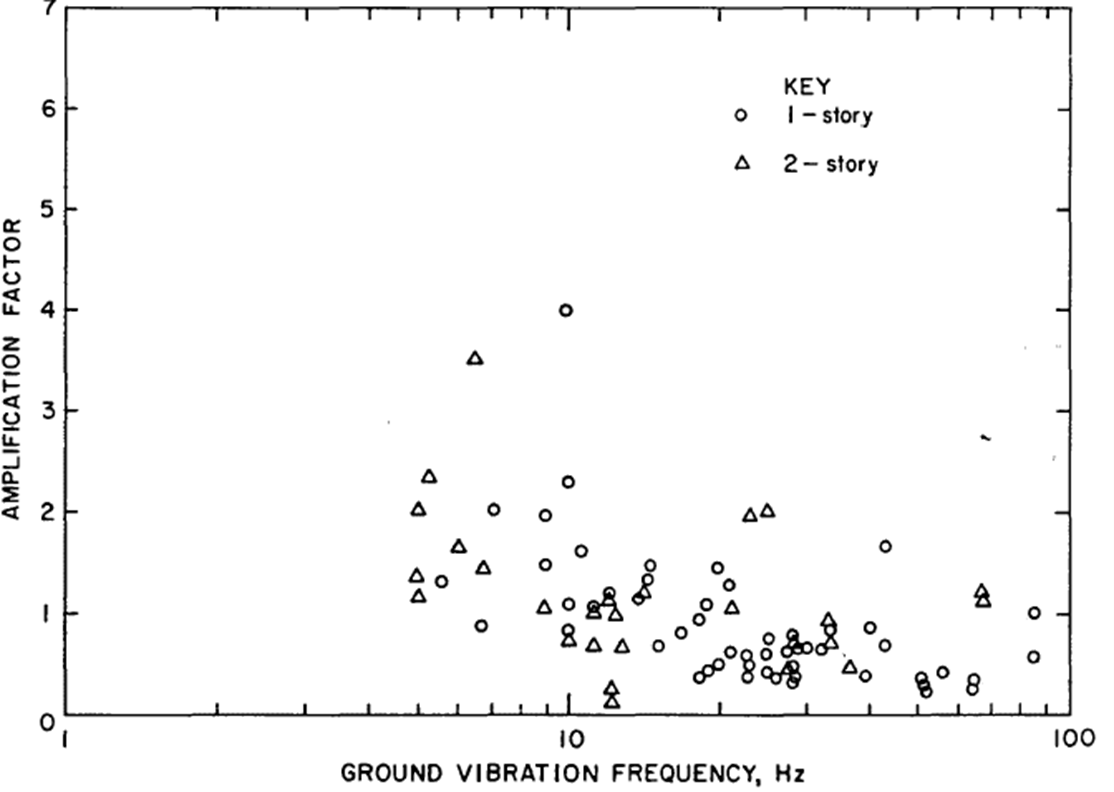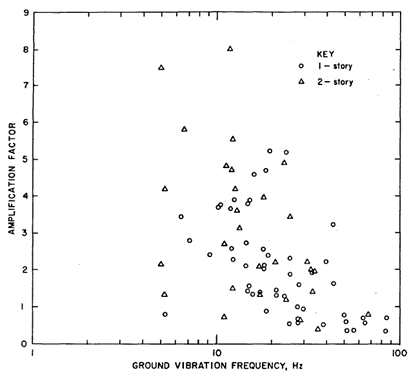Blast Vibration Basics Post #6
Structure Response and Amplification Factor
This is the sixth post in a series on blast vibration basics. Blast vibrations are an important concept to understand because all blasts produce vibrations and, in some cases, those vibrations will annoy neighbors or potentially damage nearby structures. However, in today’s environment, blast vibration damage is extremely rare due to the regulatory limits placed on blast vibrations from blasting and other construction activities.
This post focuses on residential structure response to blast vibration and structure response amplification factors. This information is an excerpt from a study I coauthored for the Florida State Fire Marshal on whether or not the US Bureau of Mines (USBM) RI 8507 vibration limit recommendations apply to Florida construction materials mining activities.
Depiction of structural response to blast vibrations [Siskind et al., 1980). The left image shows the midwall response, while the right shows the whole-structure response.
Structural Response
The USBM measured structural response from blasting vibrations with two varieties of monitoring locations, as illustrated in in the above figure. One location measured the midwall response, which is primarily responsible for window rattling and any movement of small knick-knacks [Siskind et al., 1980]. The midwall response is typically a bending motion, which does not primarily induce cracking. Midwall response can also be caused by airblast.
The second location that was measured by the USBM was on wall corners because wall corners were assumed to correspond to whole-structure response [Siskind et al., 1980]. The whole-structure response is responsible for structural damage because cracking occurs in the corners and within the planes of the walls where excessive stresses and strains are produced. Tensile strains are produced by shearing instead of bending. Shearing would be caused by whole-structure response (racking) rather than bending. Whole structure responses should be measured to characterize potential structural damage that is caused by blast vibrations.
Residential Structure Natural Frequencies Measured From Corner Motions [Siskind et al., 1980].
Two important structural response characteristics include: natural frequency and damping [Siskind et al., 1980]. Natural frequency is the frequency at which the structure amplifies excitation motions the most. Natural frequency is proportional to stiffness per unit mass [Siskind, 2000]. Damping is the structure’s resistance to vibrations and causes the motion of residential structures to die down or decay.
The blast vibration data and structural damage data that were collected during the RI 8507 study show that typical residential structures have structural natural frequencies that range from 4 to 12 Hz [Siskind et al., 1980]. Individual midwalls have structural natural frequencies from 10 to 25 Hz.
Part of the challenge of calculating frequencies results from the difficulty of determining the dominant frequency, as described in Dowding [1996]. Frequency can be determined by the zero-crossing (ZC) frequency, the peak (±70 percent of the peak frequency) of the Fourier frequency of the full wave form, or the peak of the response spectrum [Dowding et al., 2018]. Frequency measurements can produce variable results (each method is not exact), but the USBM used the ZC method to determine frequencies [Dowding et al., 2018].
Amplification Factor
Residential structures amplify blast vibrations if the blast-induced ground vibration frequencies fall within the natural frequency range of residential structures (4–12 Hz) [Siskind et al., 1980]. Outside of the natural frequency range of residential structures (both above and below the 4–12 Hz range), residential structures typically have an approximate amplification factor of unity (ground vibration and structural response nearly equal or equal).
Ground Vibration and Structure Response. This figure is an example of how amplification is calculated by the ratio of peak structure corner response to corresponding driving ground vibration [Crum, 1997].
Residential structure movement, relative to input ground vibration, is described by using amplification factors. The amplification factor is the ratio of the PPV of the structure to the corresponding particle velocity peak of the ground vibration at the base of the structure at the same moment in time or immediately preceding the peak structural vibration. The ground velocity at the same moment in time as the maximum structure response is referred to as the driving ground vibration. The amplification factor is not the ratio of the PPV of the wall to the PPV of the ground.
The USBM found that structures have different amplification factors depending on the ground-vibration frequencies [Siskind et al., 1980]:
Below 40–45 Hz
Whole structure
Whole structures typically respond with PPVs at 1.5 times the driving ground vibration particle velocity.
Whole-structure maximum PPV response values were up to 4 times the driving ground vibration particle velocities between 5 and 12 Hz. This range corresponds to the natural frequencies measured at 4–12 Hz.
Midwalls
Typically, midwalls respond at 4 times the ground vibrations in the natural frequency range.
Maximum response values were up to 8 times the ground vibrations.
Above 40–45 Hz
Whole-structure and midwall data showed that structural response was less than unity, or less than the ground vibrations.
The USBM used this analysis to prove that ground vibration frequency is just as important to consider as ground vibration particle velocity. The results led the USBM to study the effects of vibrations above and below 40 Hz separately. Note that ground motions with significant energy lower than 4–5 Hz were not recorded in the study.
Amplification Factors for Blast Vibration-Induced, Whole-Structure Vibration [Siskind et al., 1980].
Amplification Factors for Blast Vibration-Induced Midwall Vibration [Siskind et al., 1980].





